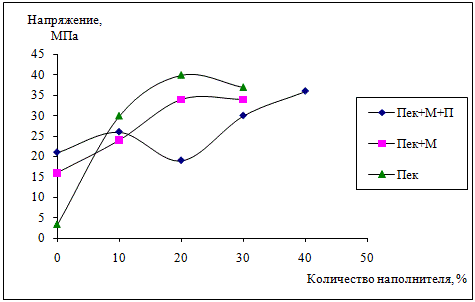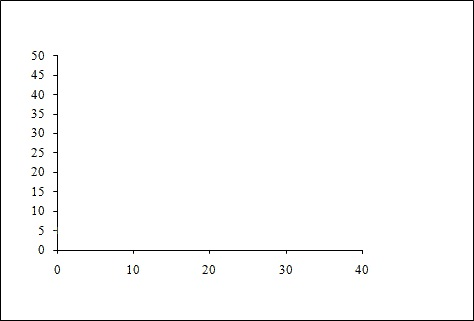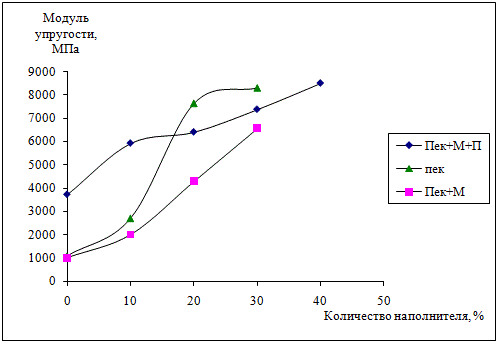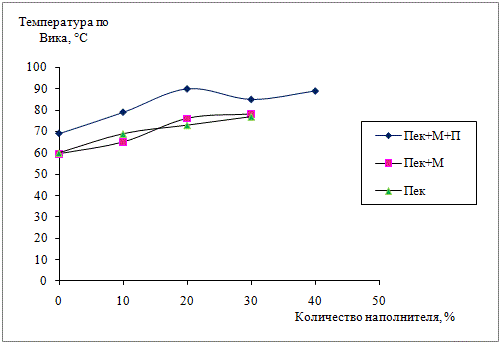
|
|
||||
| DonNTU | Master's portal || RUS | UKR | ||||
|
|
||||

|
Sergey ShiyanFaculty ecology and chemical technologySpeciality "Chemical technology of fuel and carbon materials""Research of process a dispersed filled pitch polymer obtaining"Scientific adviser: c.t.s., assistant professor Irina Krut'ko |
|
|
| Resume | ||||
|
|
||||
Abstract on the Master`s workIntroductionPurpose of work and actuality of theme1 Overview and analysis of obtaining method of dispersion-filled composite materials based on coal tar pitch1.1 Coal tar pitch - composite material1.2 Uses of coal tar pitch as construction materials2 Principles of dispersion-filled polymer composite materials creation3 Experimental part3.1 Method of dispersion-filled polymer composite materials producing3.2 Laboratory research of filler influence on the composite propertiesConclusionsLiteratureIntroductionCreation of polymer composite materials (PCM) in recent years has been the general line of development technologies for processing of plastics and is considered as the main reserve of new materials with improved properties. Another global trend - is the creation of polymer materials with the participation of carbon (or carbon-based materials), in particular the use of graphite. One of these carbon materials can be coal tar pitch. Coal tar pitch - the residue obtained by distillation of resin, which is a black product, apparently homogeneous and consists mainly of high-boiling aromatic and heterocyclic compounds. This is the most popular product of processing of coal tar [1]. Potential pitch resources in coking industry of Ukraine are estimated at approximately 500 thousand tons per year. The bulk of the coal tar pitch, which is about 25% of its resources, used to produce pitch coke and binder that are used for production of electrode products. However, in recent years there are not control fluctuations in composition and properties of carbonaceous pitches, mainly due to change of properties of coal tar. The last is associated with a change in grade of coal blend and intensify of the process of coking. This fact significantly affected the demand for coal tar pitch in the direction of its reduction. Coal tar pitch is also used as a binder (tar) road construction (about 15% of resources). However, increasing environmental requirements for materials for road construction makes futile marketing coal tar pitch in this area. In addition, it should be noted that there is now a tendency to create new polymeric materials that can replace expensive metal. Given the structure and properties of coal tar pitch, on this basis may be obtained completely new materials with the very different characteristics. Purpose of work and actuality of themeAs a result of the foregoing, it becomes important to search for new ways of rational use of the chemical potential of coal tar pitch. This work is aimed at addressing the development of alternative non-traditional method of processing, as well as skilled use of the chemical potential of coal tar pitch by creating new dispersion-filled polymer composites. The object of work - the process of obtaining pitch composite based on coal pitch. The purpose of the work - research of process a dispersed filled pitch polymer obtaining based on modified coal pitch. The main objectives of the work:
1 Overview and analysis of obtaining method of dispersion-filled composite materials based on coal tar pitch1.1 Coal tar pitch - composite materialIn [2, 3, 4, 5, 6] reasonably are developed view of the pitch as a dispersed system in which as a result of intermolecular interaction under the influence of external factors complex structural units (CSU) forming. They consist of supramolecular structures and solvated shell around them [ 4]. Coal tar pitch can be attributed to the liquid disperse system, in which communication between macromolecules in supramolecular structures are determined by the Van der Waals forces. The transformation of the physical links in the chemical leads to an irreversible complex. One can briefly formulate the following working hypothesis about the physical and chemical structures of the pitch. From the physical and chemical point of view pitch corresponds to the notion of an aromatic compound system, and the phase state refers to liquids that are under certain temperature conditions in the solid state. On the chemical composition the pitch is a complex system in which there is an almost continuous series of condensed aromatic compounds, whose sizes are limited by the size of the particles coke structure [7]. The whole system of pitch is in a nonequilibrium state and to any chemical or physical action system meets the irreversible changes in the ratio of monomeric, oligomeric and highly condensed components. In certain time-temperature conditions pitch can be regarded as a colloidal system. In which the oligomeric structure of matter (which consists of β- and α-fraction) were homogenized whole system. The term is polymer composite materials (PCM) as heterophase systems [8], obtained from two or more components (parts), where one component is a matrix, which is distributed in a certain way, another component (or other components) separated from the matrix interface. Analysis of fractional composition of coal tar pitch to estimate the influence of each group of compounds [9]:
From the above, coal tar pitch can be regarded as a dispersed heterogeneous system, which performs the role plasticizing agent is γ-fraction, and filler - α1-faction. β-fraction can be compared with the polymer medium, which are listed fractions. 1.2 Uses of coal tar pitch as construction materialsMedium temperature pitch is used as material in the manufacture of cheap plastic masses. And also pitch is used in the construction industry and road construction as a binder for thermoplastic compositions, impregnating material to provide a waterproof fabric and paper, binder for paving; as a substance that forms a film of protective varnishes coal [10]. Because of their technological properties of composite materials based on coal tar pitch, have low thermal-physical and physical-mechanical properties. Therefore, the task of creating structural materials based on coal tar pitch with improved performance represents is a promising direction of using the chemical potential of the pitch. 2 Principles of dispersion-filled polymer composite materials creationWhen creating new materials, have improved the main tasks of the complex physical and chemical properties. In this case, the main indicator of the properties is the resistance of the material destruction, that is strength. The highest strength value is typical for systems with perfect or near perfect structure. But the real strength index is always less. In many cases, together with an increase in strength when creating composite tasks is increasing the modulus of elasticity, heat resistance, resistance to impact, chemical stability, improving processability, appearance, and dimensional stability of products, etc. [8]. The fundamentally flawed aspects of composite materials are:
These causes should lead to a decrease in the strength of the composite as compared with the matrix polymer. However, in reality the introduction of the filler improves some properties of the composite. Therefore, there must be reasons for improving the properties, the effect of which is more pronounced than the effect of the above negative factors. Factors that lead to improved properties of composite materials [8]:
3 Experimental part3.1 Method of dispersion-filled polymer composite materials producingThe dispersion-filled polymer composite material is obtained using device, as shown in fig. 1.  Figure 1 - Scheme of laboratory device for dispersion-filled polymer composite material: 1 - reactor with a jacket, 2 - thermostat, 3 - screw mixer, 4 - pump, 5 - contact thermometer; 6 - controlling mercury thermometer, 7 - electric heater. There is the following technique to obtaining the dispersion-filled polymer composite material. The starting materials (coal tar pitch, modifier, filler) in the target, the experimental conditions, the ratio is stirred at 20-25 ° C until uniform. Next, obtain a homogeneous mixture is loaded into the reactor which was preheated to the desired temperature of the experiment, and is covered with lid. After a certain period of time (depending on the temperature of the experiment) when the mixture is sufficiently melted, is included mixers and intersected the right time of the experiment. At the end of the allotted time, the mixers are turned off and discharged the resulting pitch polymer. 3.2 Laboratory research of filler influence on the composite propertiesPitch or modified matrix based on it stirred in reactor for 2 hours at 170 ° C with the certain filler content. As a filler to improve the properties of the polymer composite materials used chrysotile fiberfill (CF). The main advantages of it, as a filler of thermoplastics, - is the increase in the modulus of elasticity, heat resistance and other properties of the polymer composite materials. The obtained composites were tested on a universal testing machine (fig. 2):
Vicat softening temperature was determined by ГОСТ 15088-83 (fig. 3).  Figure 2 - Universal testing machine for mechanical testing.  Figure 3 - Device for determining the heat resistance of Wicat. The results are shown in table 1 and graphically in fig. 3, 4, 5, 6, 7. Table 1 - Mechanical properties and Vicat softening temperature of pitch polymers with different matrices and filler content.
 Figure 4 - Compression stress of pitch polymers with different matrices and filler content.  Figure 5 - Bending stress of pitch polymers with different matrices and filler content (7 frames, number of reiteration 7, size 93 КВ, made in MP Gif Animator).  Figure 6 - Elastic modulus of pitch polymers with different matrices and filler content.  Figure 7 - Softening temperature of pitch polymers with different matrices and filler content. Thus, the introduction of the filler in the pitch or pitches modified matrix changes the modulus of elasticity, compressive stress and bending, heat pitch polymer. However, the great influence on the pitch polymer properties produces the conditions of mixing and forming the material, which are responsible for contacting the polymer matrix with filler. If these conditions it is impossible to obtain a homogeneous material, and thus impossible to objectively evaluate its properties. ConclusionsConducted laboratory studies have shown the possibility of obtaining a polymer composite material based on coal tar pitch with improved properties, which depend on the type of modified matrix and the amount of filler that is injected. Experimental studies have shown that the properties of pitch composite depend on the modified matrix. Great influence on the properties has a number of input pitch composite filler. To optimize the process of obtaining dispersion-filled polymer composite material it is necessary to complete a study on the interface section of the filler-matrix. Literature
|